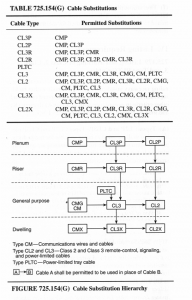First, let’s discuss controls and their enclosures in air handling spaces, ducts, and plenums. Many times, we have to install items in these spaces and it’s important to consider that anything we put in there should either be non-combustible (metal) or else be listed under UL 2043 for use in air handling spaces.
The NEC is what governs this requirement. Section 300.22(C)(3) states that, “Electrical equipment with a metal enclosure, or electrical equipment with a nonmetallic enclosure listed for use within an air handling space and having adequate fire-resistant and low-smoke-producing characteristics, and associated wiring material suitable for the ambient temperature shall be permitted to be installed in such other space unless prohibited elsewhere in the code.” An informational note included in the code defines UL 2043 as a permissible standard for such a nonmetallic product.
Not many plastic items meet this requirement, so it’s best to stick with metallic enclosures. The purpose behind this limitation is that we don’t want smoke to spread via the air handling systems in the event of a fire – and we certainly don’t want that smoke to originate inside the air handling system.
UL 2043’s title is Fire Test for Heat and Visible Smoke Release for Discrete Products and Their Accessories Installed in Air-Handling Spaces. Anything combustible (that is, not metal) installed in an air handling space should be listed to this UL standard. Confusion comes in when products have been listed to other flame test standards. A product listed as flame-spread tested to UL 94 V-0 or UL 94 H-2 is NOT the same as UL 2043, and does NOT indicate that the product is suitable for use in air handling spaces. Some inspectors will accept these flame-spread ratings, but of late that number of inspectors is dwindling. They want to see “Plenum Rated” and UL 2043 is the only standard available at this time to apply such a label. UL 94 is a test for flammability only. Smoke is the key to safety in air handling spaces.
So what’s the do-all solution? Use a metal product, or put your plastic product in a metal box. It’ll never be questioned by an inspector. Temperature sensors like the Kele KT-D and Precon ST-D are all available with metallic wiring boxes (XH or XW options). Humidity sensors like the KH-D and HD-20K have metal wiring boxes as well. Stick with these when in-duct or in-plenum mounting is essential. Of course, if in-duct or in-plenum mounting is not essential, don’t mount it in there!
Now let’s have a look at wiring in air handling spaces and chases. If not in metal conduit, there is a wide range of choices for low-voltage cabling – plenum and chase ratings have been around much longer than UL 2043, so manufacturers have made listed cables for every application. The important thing to take away from this article is that there are two very different ratings available. Plenum rating is one, and chase (riser) rating is another. Be certain that your cable is marked and listed for use in plenums and/or risers as appropriate. Substitutions may be made according to Table 725.154(G) in the NEC. In general, plenum rated cables can be used in risers, but not the other way around. Kele’s Model CBL carries both CL3R and CLP3 ratings and thus can be substituted for almost any application. Here’s a copy of Table 725.154(G), courtesy of the National Fire Protection Association. It illustrates the hierarchy of Class 2 and Class 3 cable types allowed in various spaces:
- CL3P = Class 3 Plenum
- CL2P = Class 2 Plenum
- CL2R = Class 2 Riser
- CL3R = Class 3 Riser
- PLTC = Power Limited Tray Cable
- CL2X = Class 2 Limited Use
- CL3X = Class 3 Limited Use
- CL2 = Class 2 General Purpose
- CL3 = Class 3 General Purpose
Remember, as professionals in the building automation industry we are a part of the team that is charged with preventing the spread of fire and smoke in buildings. By paying attention to what we install in plenums, ducts, and riser chases, we can insure the safety of those who inhabit our buildings.







so what is the UL Power Cables that should be used inside an ahir handling unit that supposed to pass the ETL test ?
the only optin in front of us are VW-1 Ft1 and Ft4
Greetings Mohamed,
Assuming you are referring to control wiring, the UL2043, CL3R and CLP3 at generally recognized as ETL compliant. Usually listed as “UL/ETL CL3R/CMR/FT4” as example.
Thank you!
Kele Technical Team